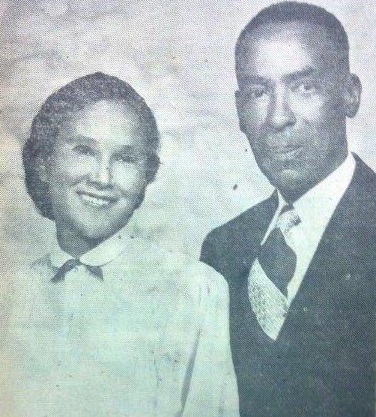African American History, California History, People
Some of Napa’s Early Black Pioneers
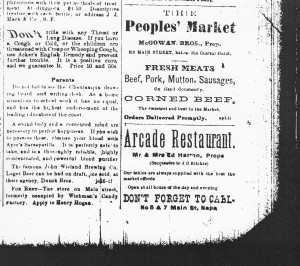 Edward and Susan Hatton arrived in Napa County in the mid-1850s, where Edward established a barbershop. He also worked as the Napa and Vallejo agent for The Elevator and Pacific Appeal, two African American newspapers.[i] He moved to Vallejo in 1865 after giving his shop to his son, Joseph, and daughter-in-law, Esther Seawell. Edward later went on to represent Vallejo on the organizing committee for the Convention of Colored Citizens of California. In 1867, he wrote an impassioned letter to the editor of The Elevator, pressing for Black suffrage, writing, “Why should we of this State be treated with so much injustice? Are we not as intelligent as any class of the community, and are we not taxed as well as others? Why this distinction? I think it is time we should be doing something for ourselves.”[ii] He later relocated to San Francisco where he worked first as a stone-cutter and later in an insurance office. When he died of rheumatism in 1889, he left behind his wife, two daughters, and ten grandchildren.[iii]
Edward and Susan Hatton arrived in Napa County in the mid-1850s, where Edward established a barbershop. He also worked as the Napa and Vallejo agent for The Elevator and Pacific Appeal, two African American newspapers.[i] He moved to Vallejo in 1865 after giving his shop to his son, Joseph, and daughter-in-law, Esther Seawell. Edward later went on to represent Vallejo on the organizing committee for the Convention of Colored Citizens of California. In 1867, he wrote an impassioned letter to the editor of The Elevator, pressing for Black suffrage, writing, “Why should we of this State be treated with so much injustice? Are we not as intelligent as any class of the community, and are we not taxed as well as others? Why this distinction? I think it is time we should be doing something for ourselves.”[ii] He later relocated to San Francisco where he worked first as a stone-cutter and later in an insurance office. When he died of rheumatism in 1889, he left behind his wife, two daughters, and ten grandchildren.[iii]
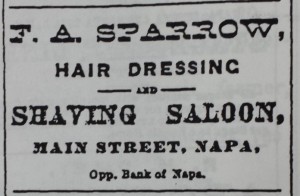 Joseph and Frederick Sparrow both served as delegates from Napa at the CCC. Joseph had been mining in California since 1849. He and his family left Napa City for the countryside to try farming, but by the early 1900s he, too, had left the county for Marysville.[iv] Sparrow was married with three children, and was educated in one of the first schools for Black children established in the 1850s. According to census records, voter registries, and burial records, by 1900 Joseph Hatton and his family also left Napa for Marysville. His wife, Esther Seawell, died in a Spanish Influenza outbreak in 1915, and Joseph passed away a year later. By 1910, Frederick Sparrow and his second wife Jennie B. Hall were living in the hamlet of Glen Ellen in Sonoma; he died the following year.
Joseph and Frederick Sparrow both served as delegates from Napa at the CCC. Joseph had been mining in California since 1849. He and his family left Napa City for the countryside to try farming, but by the early 1900s he, too, had left the county for Marysville.[iv] Sparrow was married with three children, and was educated in one of the first schools for Black children established in the 1850s. According to census records, voter registries, and burial records, by 1900 Joseph Hatton and his family also left Napa for Marysville. His wife, Esther Seawell, died in a Spanish Influenza outbreak in 1915, and Joseph passed away a year later. By 1910, Frederick Sparrow and his second wife Jennie B. Hall were living in the hamlet of Glen Ellen in Sonoma; he died the following year.
William Veasey, his wife Relieoia, their three children, and his wife’s aunt arrived in St. Helena in the late 1860s, and were the only Black family in town. He ran a barbershop on Main Street.[v] Two of their children died young, and William passed in 1890.
Of course, not all African Americans abandoned Napa County. Esther Hatton’s aunt and cousin, Matilda and Abraham Seawell, had both been brought to Napa as slaves in the 1850s by brothers William and Major Seawell. “Aunt Tillie” was the aunt of Joseph Hatton and Abraham Seawell, and passed away in 1880 in the former’s home after a brief but fatal illness. “Uncle Abe” had already lost his wife and one of his two children by the time he fell ill in the early 1890s. “He was a very popular old man, with always a pleasant word for everyone. Of a generous nature, his house was always open and he was always willing to share what little he had with those who needed assistance.”[vi] He died at 80 years old in his home.
Paul Canner came to the valley after the Civil War. He had been a slave in Missouri, and was given some money and livestock upon being freed. He and his wife Julia lived on a ranch out in Dry Creek where Paul hauled tanning bark and worked as a teamster for neighboring ranchers. Some of that property became the Enterprise School, a one-room school house that produced “an electrical engineer…[a] school teacher, registered nurse, school principal, a prominent real estate broker in Napa, and a civil engineer.”[vii] When they realized their children would not receive an adequate education that in the country, they relocated to a house on Napa Street just north of downtown Napa near the fluctuating borders of Spanishtown where Wesley Jennings was born.
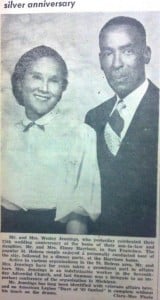 The Canners moved to St. Helena in 1893 when Wesley was six months old. As an adult, he was a skilled musician and worked as an electrician – it is said he built the first radio in town, installed the first sound film at the theater, and wired for electricity many of the old wineries. Eva, his wife, hailed from Texas, her parents also born into slavery, and came to the county looking for work as a nurse.[viii] She was employed by one of the owners of the former Schramsberg Winery, then a private residence, when they met at a dance at Tucker Farm Center where Wesley was performing with his band.[ix] The couple spent the rest of their lives living together in St. Helena. Lucinda “Lou” Strickland O’Connor, one of Paul and Julia’s daughters, also lived in Napa City for many decades. Lou was widowed twice, and her daughter, Mazie Barfield (née Strickland), lost her husband after only a few years of marriage. The mother-daughter pair lived together most of their lives in rental homes on Napa and Yajome Streets. Lou worked at a glove factory before retiring, and Mazie spent much of her working life as a fruit packer at Sunsweet Growers, a fruit company on Jackson Street.
The Canners moved to St. Helena in 1893 when Wesley was six months old. As an adult, he was a skilled musician and worked as an electrician – it is said he built the first radio in town, installed the first sound film at the theater, and wired for electricity many of the old wineries. Eva, his wife, hailed from Texas, her parents also born into slavery, and came to the county looking for work as a nurse.[viii] She was employed by one of the owners of the former Schramsberg Winery, then a private residence, when they met at a dance at Tucker Farm Center where Wesley was performing with his band.[ix] The couple spent the rest of their lives living together in St. Helena. Lucinda “Lou” Strickland O’Connor, one of Paul and Julia’s daughters, also lived in Napa City for many decades. Lou was widowed twice, and her daughter, Mazie Barfield (née Strickland), lost her husband after only a few years of marriage. The mother-daughter pair lived together most of their lives in rental homes on Napa and Yajome Streets. Lou worked at a glove factory before retiring, and Mazie spent much of her working life as a fruit packer at Sunsweet Growers, a fruit company on Jackson Street.
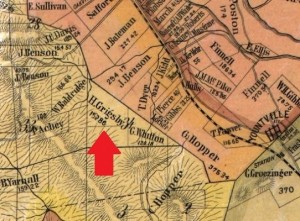 Hiram Grigsby was likely brought to Napa by the prolific Grigsby family, part of the Grigsby-Ide wagon train, the first group to travel overland to California. In 1871 he was awarded 133 acres near Yountville through the Homestead Act of 1820. Although an 1872 notice in the newspaper requested any information on his wife and children from back home (Patsey Stokes and Margaret, Amos, and Hiram Jr.), Hiram married two more times in California, first to Lucy and later to Anne Hudges, a free woman and widow from New York who had settled in Napa as a cook. Hiram was later declared insane – a catchall term for a host of physiological and psychological ailments – and he and Annie are both gone from the records by 1900.
Hiram Grigsby was likely brought to Napa by the prolific Grigsby family, part of the Grigsby-Ide wagon train, the first group to travel overland to California. In 1871 he was awarded 133 acres near Yountville through the Homestead Act of 1820. Although an 1872 notice in the newspaper requested any information on his wife and children from back home (Patsey Stokes and Margaret, Amos, and Hiram Jr.), Hiram married two more times in California, first to Lucy and later to Anne Hudges, a free woman and widow from New York who had settled in Napa as a cook. Hiram was later declared insane – a catchall term for a host of physiological and psychological ailments – and he and Annie are both gone from the records by 1900.
[Ed. note: this article is excerpted in part from the master’s thesis “There Are No Black People in Napa”: A History of African Americans in Napa County by Alexandria Brown.]
[i] Sharon McGriff-Payne, John Grider’s Century: African Americans in Solano, Napa, and Sonoma Counties from 1845 to 1925, (Bloomington, Ind.: iUniverse, 2009): 90.
[ii] Edward Hatton, letter to the editor, Elevator (San Francisco), September 27, 1867, http://cdnc.ucr.edu/cgi-bin/cdnc?a=d&d=EL18670927.2.12&srpos=18&e=–1860—1900–en–20-EL%2cPA-1–txt-txIN-colored+citizens+napa——.
[iii] “Death of a Pioneer,” Napa Register, February 8, 1889, microfilm.
[iv] McGriff-Payne, John Grider’s Century, 89-90.
[v] Philip A. Bell, “St. Helena and Calistoga,” Elevator (San Francisco), June 28, 1873, http://cdnc.ucr.edu/cgi-bin/cdnc?a=d&d=EL18730628.2.10&srpos=7&e=——-en–20-EL%2cPA-1–txt-txIN-veasey——#.
[vi] “Death of Abe Seawell,” Napa Daily Journal, April 24, 1894, microfilm.
[vii] John Wichels, “The Pioneer One-Room Schools of Napa County,” MS 23, 1979, Manuscript Collection, Napa County Historical Society, Napa, CA.
[viii] Kathy Kernberger and Shirley Penland, “Now & Then: A Look through Photographs, at the People and Places of St. Helena in Years Past,” St. Helena Star, March 27, 1997.
[ix] Pam Hunter, “Native Son and St. Helena Music Man,” St. Helena Star, June 2, 1973, Ephemera Collection, Napa County Historical Society.


